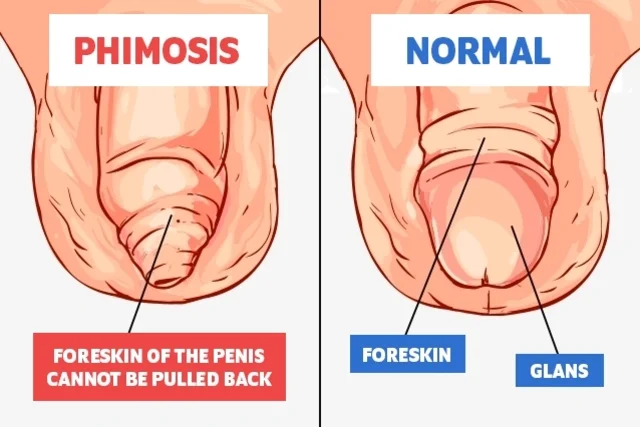
Introduction
Phimosis is a common condition that affects the male population, particularly infants and young children. It is characterized by the narrowing of the foreskin, making it difficult or impossible to retract over the glans penis. While this condition may naturally resolve in some cases as a child grows older, persistent or severe phimosis can lead to discomfort and potential complications. Understanding the symptoms of phimosis is essential to ensure timely diagnosis and appropriate treatment. In this article, we will explore the symptoms, causes, and available treatment options for phimosis.
Symptoms of Phimosis
Difficulty Retracting the Foreskin: The most evident and primary symptom of phimosis is the inability to retract the foreskin fully. In infants, this may be a normal physiological condition that resolves naturally as they age. However, if this inability persists beyond the age of three or four, it may require medical attention.
Pain or Discomfort: As the foreskin narrows, attempting to retract it may cause pain or discomfort in affected individuals. This discomfort can be particularly noticeable during activities such as urination or sexual intercourse.
Redness and Swelling: In some cases, phimosis may lead to inflammation of the foreskin, resulting in redness and swelling around the tip of the penis. This can further exacerbate discomfort and make daily activities more challenging.
Ballooning of the Foreskin: During urination, individuals with phimosis may experience ballooning of the foreskin, where urine collects under the tight foreskin and causes it to puff up. This can be a concerning symptom that requires medical attention.
Recurrent Infections: Phimosis can make cleaning under the foreskin difficult, leading to a buildup of smegma (a combination of dead skin cells, oils, and other bodily secretions). This buildup can become a breeding ground for bacteria and increase the risk of infections such as balanitis, which is the inflammation of the glans penis.
Causes of Phimosis
Congenital Phimosis: Some infants are born with a tight foreskin, which is referred to as congenital phimosis. This condition may naturally improve as the child grows, and the foreskin becomes more flexible. However, if it persists or worsens over time, medical intervention may be necessary.
Scarring: Phimosis can also develop due to scarring of the foreskin caused by infections, injuries, or repeated irritation.
Infections: Certain infections, such as balanitis or posthitis (inflammation of the foreskin), can lead to the development of phimosis.
Poor Hygiene: Inadequate cleaning of the genital area can result in the accumulation of smegma, leading to infections and inflammation that may contribute to phimosis.
Treatment Options for Phimosis
The treatment for phimosis depends on its severity, age of the patient, and underlying causes. Here are some common treatment options:
Observation: In young children, especially infants, mild cases of phimosis may be observed and allowed to resolve naturally as the child grows older.
Topical Steroid Creams: For mild cases, doctors may prescribe topical steroid creams that can help reduce inflammation and promote the stretching of the foreskin.
Gentle Manual Stretching: Healthcare professionals may recommend gentle manual stretching exercises to gradually widen the foreskin opening. This technique should be performed with care and under medical supervision to avoid injury.
Preputioplasty: In cases where conservative measures fail, a preputioplasty can be considered. This is a minor surgical procedure that involves making a small incision in the foreskin to widen it while preserving its original structure.
Circumcision: In severe or recurrent cases of phimosis, circumcision, the surgical removal of the foreskin, may be recommended. Circumcision is a more invasive procedure and is usually considered after other treatment options have been explored.
Conclusion
Phimosis is a common condition characterized by the narrowing of the foreskin, which can lead to discomfort, pain, and potential complications. Recognizing the symptoms of phimosis is crucial to seek appropriate medical attention. While some cases may resolve naturally, persistent or severe phimosis may require treatment options such as topical creams, gentle stretching exercises, preputioplasty, or circumcision. If you or your child experience symptoms of phimosis, it is essential to consult a healthcare professional for an accurate diagnosis and appropriate management.
